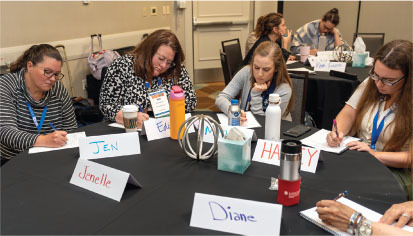January/February 2014
LEADING INSIGHT
Four Critical Actions to Build a Culture Of Accountability in 2014
BY JULIE MILLER AND BRIAN BEDFORD
 Almost every leader has been there. One minute you’re living the company values, and the next you’re making an exception—for yourself. Perhaps you have an official policy of being super-responsive, but when an especially problematic client calls, you avoid him for a day or two. Or despite a stated commitment to respectful communication, you lose it and shout at Margaret in sales when she falls short of her quarterly goal once again. Or you have a no-excuses policy on deadlines, but when you personally miss one, you just finesse the client into giving an extension.
Almost every leader has been there. One minute you’re living the company values, and the next you’re making an exception—for yourself. Perhaps you have an official policy of being super-responsive, but when an especially problematic client calls, you avoid him for a day or two. Or despite a stated commitment to respectful communication, you lose it and shout at Margaret in sales when she falls short of her quarterly goal once again. Or you have a no-excuses policy on deadlines, but when you personally miss one, you just finesse the client into giving an extension.
Sure, we all make mistakes. But if you’re not holding yourself accountable to the values you say are important, don’t be surprised when your bad behavior starts to trickle down and ultimately impacts the company’s bottom line.
Company leaders should be aware of the “as above, so below” phenomenon: the concept in which employees mirror the behaviors of the successful leaders they see above them. The rationale is simple: If they get ahead by behaving that way, then that’s what I’ll do. That’s great when leaders are acting with accountability, but it becomes a big problem when leaders don’t make accountability a priority.
To be successful, a company’s leaders must apply the relentless focus and commitment necessary to build the required culture and must serve as role models for the required behaviors. In the end, the establishment of a culture is all about how leaders behave and what behaviors they reward and discourage. Read on to learn the four critical actions leaders must take in order to create a winning culture.
No. 1—Hold yourself accountable.
One example is Sir Alex Ferguson, the long-time coach of the Manchester United soccer club, who held everyone, including himself, accountable to the credo, “The club is more important than any individual.” No matter how skilled or important they were, if a player didn’t follow that rule, they were let go. And remember, you must hold yourself accountable to at least the same level of expectation you have for your employees. A rule applies to everyone or it applies to no one.
No. 2—Spell out expectations to the letter.
Without clear expectations, there’s no way to hold someone accountable. You must make sure that each employee has a clear understanding of what is expected of them in the job he or she performs.
No. 3—Know when to nourish your employees.
Of his time at General Electric, Jack Welch once said, “My main job was developing talent. I was a gardener providing water and other nourishment to our 750 people. Of course, I had to pull out some weeds, too.” It’s clear that Welch had a standard for his employees, and anyone who didn’t meet that standard would suffer the consequences.
Holding people accountable isn’t easy. You have to tell your employees the truth. You can’t do this without having conversations with people about what they are doing well and where they need to improve. This is where the accountability process breaks down most often.
No. 4—Hone the art of instant feedback.
For feedback to be productive, it must be shared regularly and without delay. Make sure feedback is specific, focusing on the particular issue or behavior in question. If a leader will focus on what the person actually said or did—the facts and nothing but the facts—without labeling the employee or the action, the employee will be more likely to hear and heed the feedback.
You can also use the S.I.S. Feedback Model. It is a straightforward and objective process in which you first describe the situation, then explain the impact it had, and then suggest ways to stop (or continue) the behavior.
In order to establish a culture of accountability, there can be no double standard. Leaders and employees must follow the same set of rules; otherwise the whole system breaks down. The good news is that when leaders commit to role modeling the right behaviors, their employees will follow.
Julie Miller and Brian Bedford are coauthors of Culture Without Accountability—WTF: What’s the Fix? In 2001, drawing on their respective years of experience in senior global leadership at Motorola, they joined forces to establish MillerBedford Executive Solutions. For more information, visit
www.millerbedford.com.


 Volunteering at NSPE is a great opportunity to grow your professional network and connect with other leaders in the field.
Volunteering at NSPE is a great opportunity to grow your professional network and connect with other leaders in the field. The National Society of Professional Engineers (NSPE) encourages you to explore the resources to cast your vote on election day:
The National Society of Professional Engineers (NSPE) encourages you to explore the resources to cast your vote on election day:




